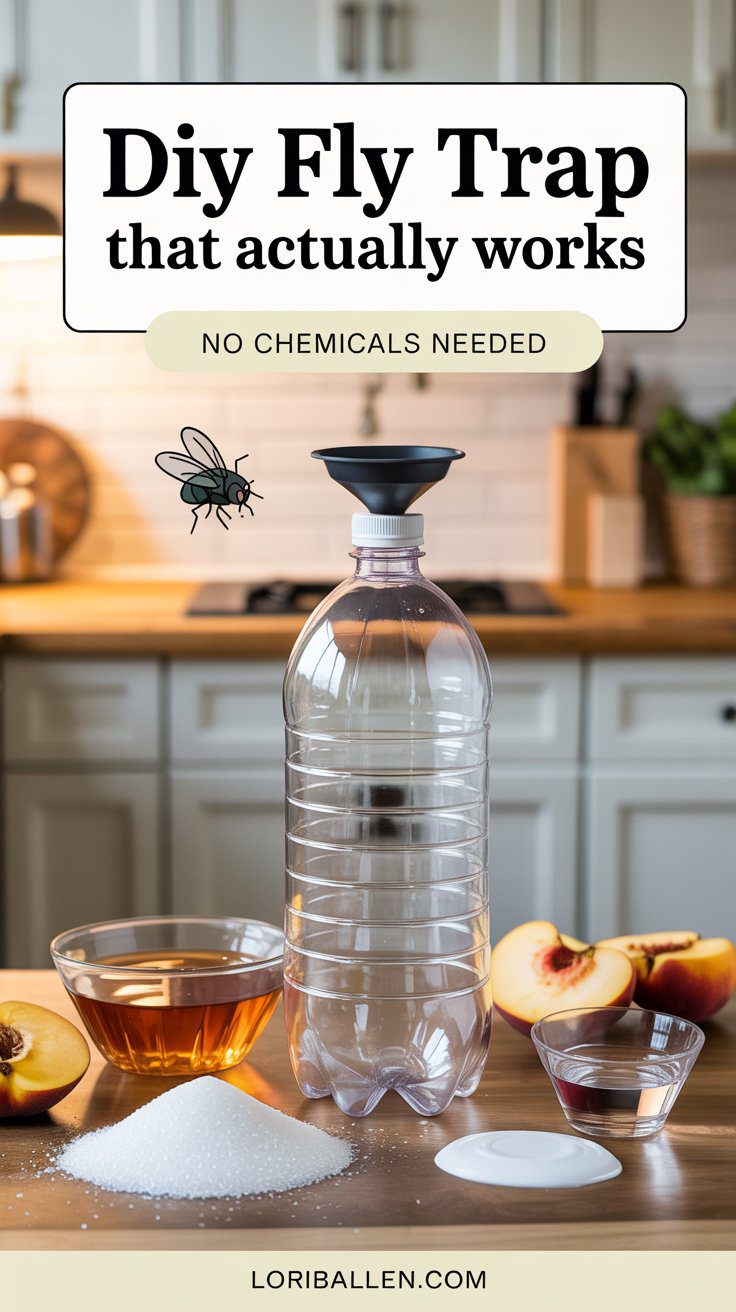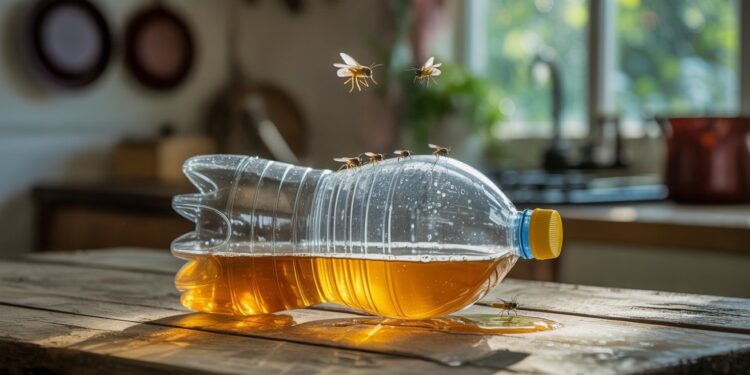This website contains affiliate links. Some products are gifted by the brand to test. As an Amazon Associate, I earn from qualifying purchases. The content on this website was created with the help of AI.
I don’t know who needs to hear this, but if you’ve got a fly problem, you don’t need to spend a dime on sprays or traps packed with chemicals. You’ve probably already got everything you need to make a killer fly trap sitting in your kitchen right now. I’ve tested these DIY fly traps myself—yes, even the one with the funky bait—and they actually work. In this post, I’m breaking down exactly how to make one, where to put it, and what bait lures in the most flies fast. Ready to ditch the swatter? Let’s do it.

Here’s what you need to know before diving in:
- DIY fly traps work. They’re cheap, effective, and chemical-free.
- Flies are drawn to anything smelly and sweet—use that to your advantage.
- You probably have everything you need already: plastic bottle, vinegar, sugar, water, dish soap.
- Let your bait sit out and ferment—gross for you, irresistible for them.
- Placement matters. So does maintenance. Set it, but don’t forget it.
What is a DIY Fly Trap?
A DIY fly trap is exactly what it sounds like—something you whip up at home with what you’ve already got in your kitchen or recycling bin. No sprays. No zappers. Just simple ingredients that lure flies in and keep them there. These traps are cheap, fast to make, and surprisingly effective when you get the bait right.
Why bother? Because traditional bug sprays are filled with chemicals you don’t want around your food, pets, or kids. DIY fly traps give you a natural, eco-friendly way to reclaim your space—especially when the weather warms up and flies seem to multiply overnight.
Understanding the Need for Natural Pest Control
Many are worried about the negative effects of traditional bug sprays, so there’s a big push for homemade fly-catcher solutions. These natural methods, like the DIY fly trap, offer a better way to handle fly problems. They are good for the planet and safe for our health.
Benefits of a Homemade Fly Trap
There are lots of good things about a homemade fly trap. They are cheap to make since you can use things you already have at home. This makes them a smart choice for saving money. Also, they are natural and eco-friendly. They help keep flies away from your family and pets without using any bad chemicals.
These DIY traps work by luring and catching flies. They keep your home and outdoor areas healthy and free from flies.
Materials Needed for a DIY Fly Trap
ou don’t need fancy tools or a trip to the store—just grab what’s already lying around the house. The beauty of this project is how simple (and cheap) it is to pull off.
Plastic Bottle
Any clear plastic bottle will do—a soda or water bottle is perfect. You’ll cut and flip it to make the fly funnel.
Water + Dish Soap
Add water and a squirt of dish soap to your trap. The soap breaks the surface tension so the flies sink instead of escaping.
Bait
This is where the magic happens. Flies love anything smelly and sweet. Think sugar water, overripe fruit, raw meat, or even pet waste if you’re outdoors. The riper, the better—fermentation makes it more irresistible.
Step-by-Step Guide to Making a DIY Fly Trap
Making your own fly trap takes just a few minutes—and the payoff is huge. Here’s how to build one that works, using stuff you already have on hand.
1. Prep the Bottle
Grab a clean plastic bottle (a soda or water bottle works great). Cut it in half with scissors or a sharp knife. You’ll use the bottom half for the bait and flip the top half upside down to create a funnel that guides flies in—but makes it hard for them to escape.
2. Mix the Bait
In the bottom half of the bottle, pour in your chosen bait. A simple mix of sugar water works, or level up with apple cider vinegar and overripe fruit. Want it stronger? Add a splash of dish soap. That breaks surface tension and helps trap the flies once they land.
3. Assemble the Trap
Insert the top half of the bottle upside down into the bottom, funnel-style. You should now have a simple trap with a narrow opening that draws flies in but keeps them from flying back out.
4. Set It Up
Place your trap in a sunny spot near fly-prone areas like trash cans, compost bins, or pet feeding stations. Let it sit for a few days, then check the results.
DIY Fly Trap Bait Recipes
The bait used in your DIY fly trap is very important. It brings in and catches those annoying flies. Luckily, you can make your own fly attractant with things you probably already have at home.
Sugar Water or Honey Water
A simple bait mix is sugar water or honey water. The sweetness pulls flies in, making this a great choice.
Overripe Fruit
Overripe fruit like bananas and strawberries is a natural fly magnet. It releases a smell that flies just can’t resist. That’s why it’s perfect for your fly trap.
Raw Meat or Manure
Want something stronger? Try raw meat or animal manure. Their powerful scents are like a magnet for flies. This makes them superior choices for your DIY trap.
Whichever bait you go with, give it time to develop. Let it ferment for a few days to really attract the flies.Also, don’t be afraid to try mixing in a little dish soap with your bait. This can boost the trap’s ability to catch flies.
Finding the perfect bait is the heart of making a good DIY fly trap. Test out these homemade recipes to keep your space free from flies. You’ll soon have a trusted method to fight off these pests.
Placement and Maintenance of Your DIY Fly Trap
Placing your DIY fly trap right and keeping it up is key. With some easy steps, you can make sure it lures and traps flies well. Say goodbye to pesky visitors in your home or outside areas.
Optimal Locations for Trap Placement
Think smart about where to place DIY fly trap. You want it where flies like to hang out the most. Indoors, place it by food sources like fruit bowls, trash bins, or spill areas.7 For outside, pick spots near compost heaps, trash cans, or rotting organic matter. Flies breed in these places. But don’t put it right by doors or windows. That could bring more flies indoors.
Monitoring and Refreshing the Trap
Looking after your homemade fly trap makes it work better. Check it every day and clean out any caught flies. Change the bait every few days to keep the scent strong. Add fresh fruit, sugar water, or whatever bait you’re using.7 A clean trap is a better trap. It will keep attracting and trapping flies well.
Follow these steps for where to place DIY fly trap and maintaining homemade fly trap. Your homemade fly trap will do its job well. Say hello to a fly-free area, whether inside or outdoors.
Tips and Tricks for Effective Fly Control
If you want your DIY fly trap to work well, there are some tips. DIY fly control tricks include choosing the right bait. For the best results, we suggest using raw shrimp. It’s very effective and can catch hundreds of flies in just 4 days.
Another good bait is a mix of ½ cup water, ½ cup vinegar, 2 tablespoons sugar, and 1 tablespoon dish soap. This mix works great for keeping flies away inside your home.
Where you put the trap matters a lot. It should go in places where flies hang out the most. This could be near the trash, your pet’s food, or where you eat outside. Also, make sure to change the bait often to keep the trap working well.
As shown by the data, the best DIY fly trap is a Mason jar with small holes in the lid. It trapped over 50 fruit flies. People found this trap to be very effective, easy to make, and it looked nice too. It got the highest scores.
Using homemade fly traps not only works well but also helps the environment. You won’t need to use harmful chemicals. By using these tips and tricks, your home or the area outside can be free of flies with things that are simple and safe.
Conclusion
The DIY fly trap shown here is a cheap and green way to fight flies at home. It uses things like old fruit, vinegar, and sugar. These attract flies and then trap them. This makes it safer than using chemicals.
Making your own fly trap saves money and is good for the planet. It fits with the trend for natural pest control. Plus, you can change the bait and design to see what works best for you.3
Yes, making a fly trap does take some work upfront. But, it really pays off over time. You’ll see fewer flies around and enjoy a bug-free home. Just follow the simple steps in this guide. Soon, you’ll have a trap that really works. So, why not start making your eco-friendly trap now?
FAQ
What is a DIY fly trap and how does it work?
A DIY fly trap is a great way to keep flies away at home. You use common things, like a plastic bottle, to catch the flies. These are attracted by a mix of bait and get stuck inside.
Why should I use a homemade fly trap instead of other pest control methods?
Making your own fly trap is good for the planet and your wallet. It’s better than using strong chemicals. Plus, it’s very simple to make and safe for everyone.
What materials do I need to make a DIY fly trap?
All you need is a plastic bottle, some water, a bit of soap, and a bait mix. Items like sugar water or pieces of fruit make a good bait. Mix them up, and you’re ready to catch those flies!
How do I assemble a DIY fly trap?
First, you cut the plastic bottle in half to make the trap. Then, you mix up your bait. Finally, you put it all together following easy steps. It’s that simple!
What type of bait works best in a homemade fly trap?
Sugar water, honey, ripe fruit, or even meat can be great baits. They attract the flies and keep them trapped. You can choose what works best for you.
Where should I place my DIY fly trap for the best results?
Put your fly trap where flies like to hang out, such as by trash or pet waste. Remember to keep the bait fresh. This will help catch more flies.
Do you have any additional tips for using a DIY fly trap effectively?
There are many ways to make your fly trap more effective. The key is to keep the bait new and put the trap in the right spot. Be ready to fix any problems too.
This website contains affiliate links. Some products are gifted by the brand to test. As an Amazon Associate, I earn from qualifying purchases. The content on this website was created with the help of AI.









 I Bought Two Houses?!
I Bought Two Houses?! 